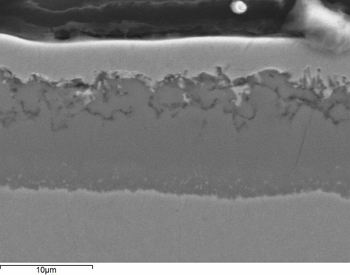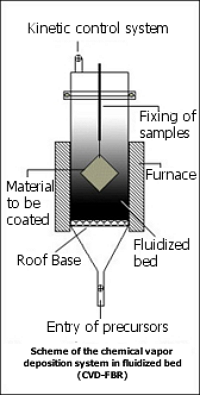PROTECTIVE COATINGS AGAINST WEAR AND CORROSION AT HIGH TEMPERATURE BY CVD IN FLUIDIZED BED
|
Description |
This technique involves Chemical Vapor phase Deposition (CVD) of specific coatings against corrosion and wear by the use of a Fluidized Bed Reactor (FBR).
|
How does it work |

Micrograph of SEN X 3000, cross section of the material coated with aluminum using CVD-FBR.
The principle of the technique is based on leveraging the characteristics of mass and heat transfer that enables a fluidized bed reactor, reducing time and temperature in the equipment of coating application, which means a first advantage from the economic point of view. It also works at atmospheric pressure, which saves the expensive vacuum equipment and coating large pieces in-situ.
The coating is performed by generating vapor precursors, which react to form the species that constitute the coating.
Once deposited the proper coating, the piece in question present a greater resistance to wear and/or corrosion, which present in all cases a higher value-added finished product.
|
Advantages |
It allows the whole range of metallic and ceramic coatings in fluidized bed reactor, which operating at atmospheric pressure does not need additional vacuum equipment, like most coatings techniques. It also allowscoating under conditions of time and temperature well below normal, internal cooling channels and pipes, with the consequent economic improvement.
|
Where has it been developed |

CVD-FBR scheme.
The technique of Chemical Vapor phase Deposition in Fluidized Bed Reactor has been developed in the Materials Science and Metallurgical Engineering Department, Faculty of Chemical Science, under the direction of Professor Francisco Javier Perez Trujillo. This technique has been implemented in Spain, thanks to the close collaboration between the Stanford Research Institute (SRI) and the research group UCM for 25 years.
Since the beginning of the collaboration we are still in close contact with the SRI, which has allowed to incorporate the latest advances in coatings technology as sophisticated as Functionally Graded.
The studies have focused on improving reactor Chemical Vapor phase Deposition (CVD-FBR), to perform various types of coatings to various industrial needs, in applications with a considerable economic return.
It is being applied to coat turbine blades (chrome/aluminizing) for a company in Madrid, in collaboration with the Air Force. The technology is being implemented on an industrial scale, being able to develop specific coatings that will require the protection of intellectual property in each case. The works in this field have an extensive application in the USA and Japan, so it will be a technology widely deployed in the Spanish industry in the next decade.
|
And also |
At the current level of development, it could provide the following services to the industry:
- Carry out technical feasibility studies for a particular application.
- Making coating of small and medium size parts.
- Possibilities of technical assistance after purchase.
- Sulphidation and Chlorination
- Computational design of protective coatings.
- Evaporation of materials at high temperature: MS
|
Contact |
|
© Office for the Transfer of Research Results – UCM |
|
PDF Downloads |
|
Classification |
|
Responsible Researchers |
Francisco Javier Pérez Trujillo: fjperez@ucm.es
Department: Material Sciences and Metallurgic Engineering
Faculty: Chemical Sciences


